Purchas D. Handbook of Filter Media
Подождите немного. Документ загружается.


Glossary 517
Molecular sieve
A material with extremely fine pores, capable of the adsorption of molecular
species, such as water.
Monofilament
A single filament used as the yarn to weave fabrics or meshes.
Moulded
In this context, refers to the formation of media into shapes by moulding - the
resultant format may be held in shape by a bonding resin, or by thermal
treatment.
Multifilament
A yarn made of a number of filaments, twisted as required.
Nanofiltration
A filtration region fairly recently separated between reverse osmosis and
ultrafiltration, both in size of species separated, and in operating pressure.
Napping
A finishing process for fabrics that raises short fibres above the surface of the
medium
Natural (fibres, filaments)
Materials derived from animal or vegetable sources: cellulose, cotton, silk and
wool in filtration terms, although flax/linen, jute and other fibres are used.
Needlefelt
A felt that has been stabilized and strengthened by needling.
Needling
The processing of felts (and some other non-woven materials) by rapid
puncturing of the material with a set of barbed needles.
Non-woven
Any textile fabric made by methods other than weaving and knitting.
Osmosis
The passage of a solvent (usually water) from a dilute solution to a more
concentrated solution through a semi-permeable membrane, the driving force
being the difference in osmotic pressure across the membrane.
Panel
A fiat pad of filter media, held in a simple frame, that may be square or
rectangular in shape. Used mainly for air conditioning applications, and
sometimes called a cassette.

518 Handbook of Filter Media
Paper
A medium made by wet laying of cellulose or glass fibres.
Particle
A small granule of solid material, the basic component of dusts or other
suspensions.
Pathogen
Any body capable of transferring disease to humans. Especially bacteria and
viruses.
Penetration
The passage of a particle or droplet through a filter medium. The degree of
penetration measures the efficiency of the filter.
Perforated, perforation
Usually means sheet material (metal or plastic) in which holes are machined,
by drilling or punching. Used for coarse filtration.
Permeable, permeability
Open to the passage of specific components of a mixture. Permeability is a
measure of the degree of openness.
Permeate
The clear liquid passing through a membrane, either by diffusion through the
body of the material, or passage through continuous pores. (See also filtrate)
Permeation
Processes that operate by separation at a barrier, usually referring to the
microscopic scale.
Pervaporation
A membrane separation process for one liquid from another, by passage of one
component as vapour through the membrane, with a vacuum maintained on the
downstream side.
Plain weave
The simplest form of weaving" over one yarn, then under one, for the entire
material.
Plastic
Specifically, any deformable material, but used generically of all synthetic
polymeric materials.
(Filter) plate
May refer to a component of a plate-and-flame filter press, which holds the
filter medium and the formed cake, or may be an equivalent word to 'leaf, i.e. a
rigid structure made from sheets of filter media, sealed at their periphery.
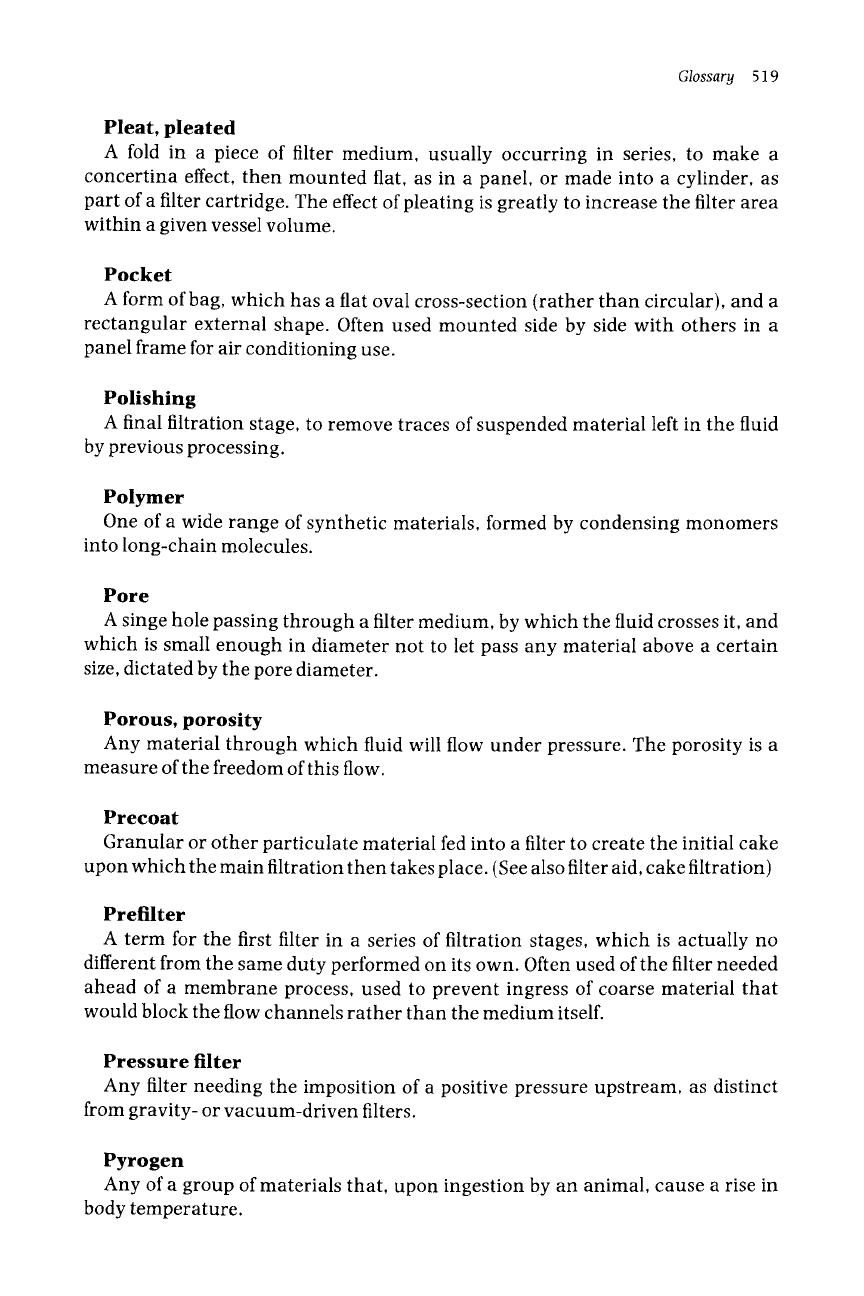
Glossary 519
Pleat, pleated
A fold in a piece of filter medium, usually occurring in series, to make a
concertina effect, then mounted fiat, as in a panel, or made into a cylinder, as
part of a filter cartridge. The effect of pleating is greatly to increase the filter area
within a given vessel volume.
Pocket
A form of bag, which has a flat oval cross-section (rather than circular), and a
rectangular external shape. Often used mounted side by side with others in a
panel frame for air conditioning use.
Polishing
A final filtration stage, to remove traces of suspended material left in the fluid
by previous processing.
Polymer
One of a wide range of synthetic materials, formed by condensing monomers
into long-chain molecules.
Pore
A singe hole passing through a filter medium, by which the fluid crosses it, and
which is small enough in diameter not to let pass any material above a certain
size, dictated by the pore diameter.
Porous, porosity
Any material through which fluid will flow under pressure. The porosity is a
measure of the freedom of this flow.
Precoat
Granular or other particulate material fed into a filter to create the initial cake
upon which the main filtration then takes place. (See also filter aid, cake filtration)
Prefilter
A term for the first filter in a series of filtration stages, which is actually no
different from the same duty performed on its own. Often used of the filter needed
ahead of a membrane process, used to prevent ingress of coarse material that
would block the flow channels rather than the medium itself.
Pressure
filter
Any filter needing the imposition of a positive pressure upstream, as distinct
from gravity- or vacuum-driven filters.
Pyrogen
Any of a group of materials that, upon ingestion by an animal, cause a rise in
body temperature.
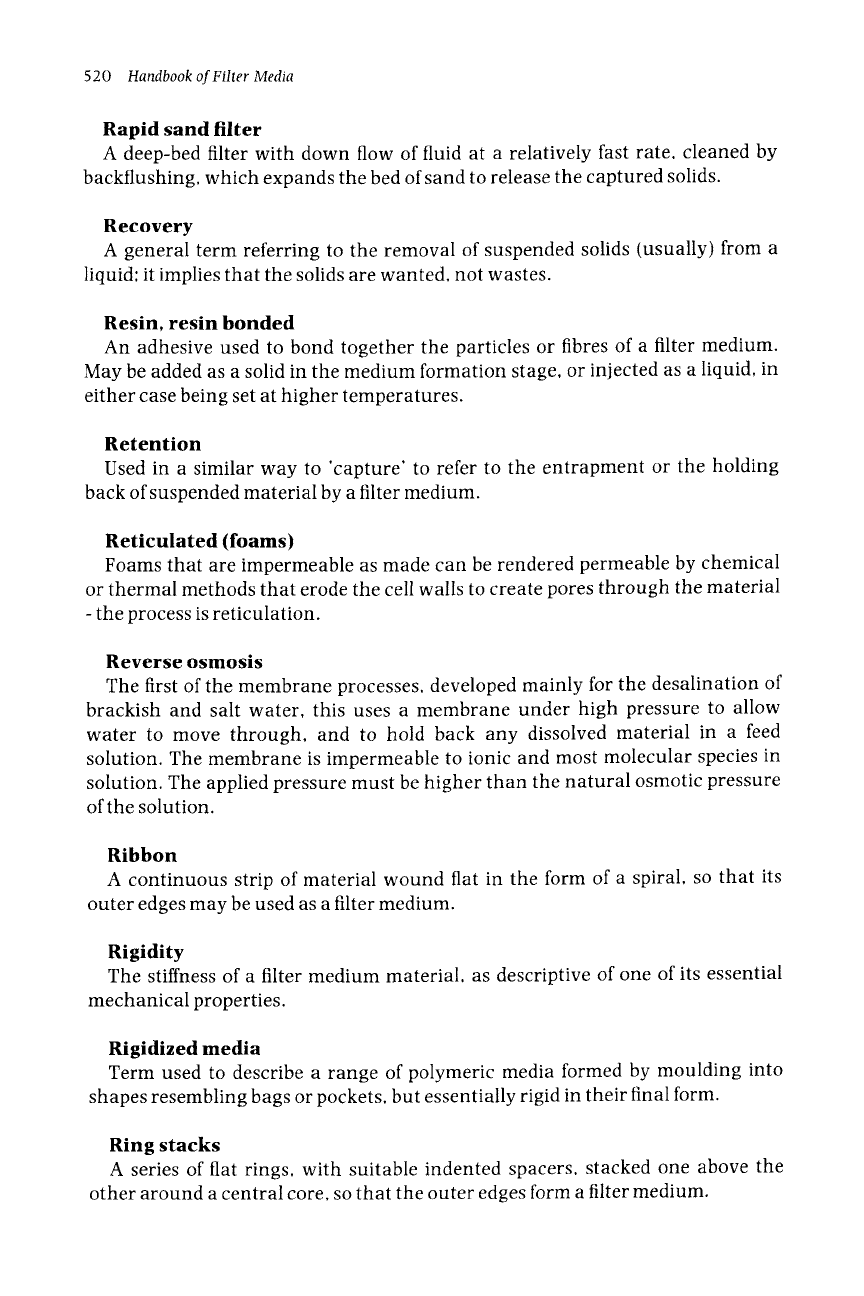
520
Handbook of Filter Media
Rapid sand filter
A deep-bed filter with down flow of fluid at a relatively fast rate, cleaned by
backflushing, which expands the bed of sand to release the captured solids.
Recovery
A general term referring to the removal of suspended solids (usually) from a
liquid; it implies that the solids are wanted, not wastes.
Resin, resin bonded
An adhesive used to bond together the particles or fibres of a filter medium.
May be added as a solid in the medium formation stage, or injected as a liquid, in
either case being set at higher temperatures.
Retention
Used in a similar way to 'capture' to refer to the entrapment or the holding
back of suspended material by a filter medium.
Reticulated (foams)
Foams that are impermeable as made can be rendered permeable by chemical
or thermal methods that erode the cell walls to create pores through the material
- the process is reticulation.
Reverse osmosis
The first of the membrane processes, developed mainly for the desalination of
brackish and salt water, this uses a membrane under high pressure to allow
water to move through, and to hold back any dissolved material in a feed
solution. The membrane is impermeable to ionic and most molecular species in
solution. The applied pressure must be higher than the natural osmotic pressure
of the solution.
Ribbon
A continuous strip of material wound fiat in the form of a spiral, so that its
outer edges may be used as a filter medium.
Rigidity
The stiffness of a filter medium material, as descriptive of one of its essential
mechanical properties.
Rigidized media
Term used to describe a range of polymeric media formed by moulding into
shapes resembling bags or pockets, but essentially rigid in their final form.
Ring stacks
A series of flat rings, with suitable indented spacers, stacked one above the
other around a central core, so that the outer edges form a filter medium.
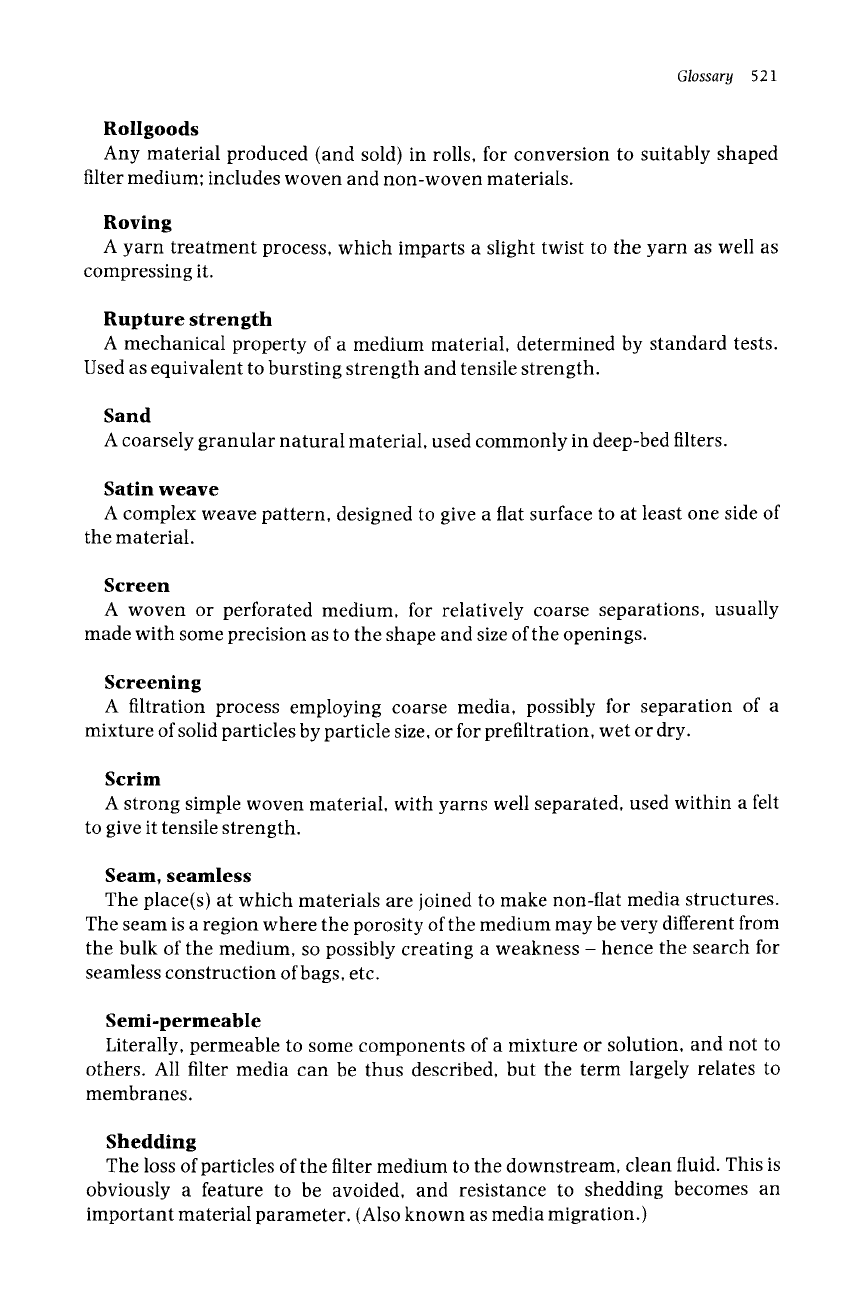
Glossary 521
Rollgoods
Any material produced (and sold) in rolls, for conversion to suitably shaped
filter medium; includes woven and non-woven materials.
Roving
A yarn treatment process, which imparts a slight twist to the yarn as well as
compressing it.
Rupture strength
A mechanical property of a medium material, determined by standard tests.
Used as equivalent to bursting strength and tensile strength.
Sand
A coarsely granular natural material, used commonly in deep-bed filters.
Satin weave
A complex weave pattern, designed to give a flat surface to at least one side of
the material.
Screen
A woven or perforated medium, for relatively coarse separations, usually
made with some precision as to the shape and size of the openings.
Screening
A filtration process employing coarse media, possibly for separation of a
mixture of solid particles by particle size, or for prefiltration, wet or dry.
Scrim
A strong simple woven material, with yarns well separated, used within a felt
to give it tensile strength.
Seam, seamless
The place(s) at which materials are joined to make non-flat media structures.
The seam is a region where the porosity of the medium may be very different from
the bulk of the medium, so possibly creating a weakness - hence the search for
seamless construction of bags, etc.
Semi-permeable
Literally, permeable to some components of a mixture or solution, and not to
others. All filter media can be thus described, but the term largely relates to
membranes.
Shedding
The loss of particles of the filter medium to the downstream, clean fluid. This is
obviously a feature to be avoided, and resistance to shedding becomes an
important material parameter. (Also known as media migration.)
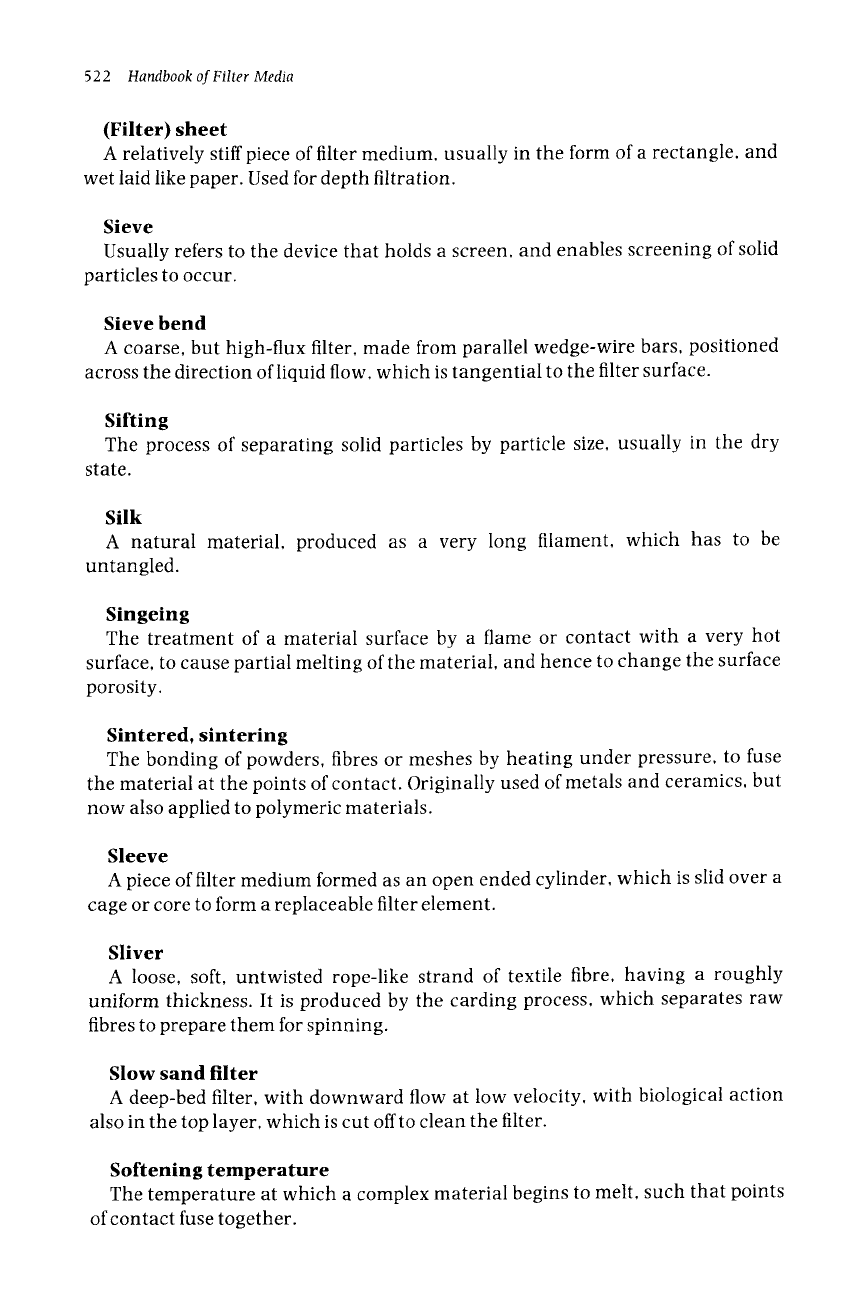
522
Handbook of Filter Media
(Filter) sheet
A relatively stiff piece of filter medium, usually in the form of a rectangle, and
wet laid like paper. Used for depth filtration.
Sieve
Usually refers to the device that holds a screen, and enables screening of solid
particles to occur.
Sieve bend
A coarse, but high-flux filter, made from parallel wedge-wire bars, positioned
across the direction of liquid flow, which is tangential to the filter surface.
Sifting
The process of separating solid particles by particle size, usually in the dry
state.
Silk
A natural material, produced as a very long filament, which has to be
untangled.
Singeing
The treatment of a material surface by a flame or contact with a very hot
surface, to cause partial melting of the material, and hence to change the surface
porosity.
Sintered, sintering
The bonding of powders, fibres or meshes by heating under pressure, to fuse
the material at the points of contact. Originally used of metals and ceramics, but
now also applied to polymeric materials.
Sleeve
A piece of filter medium formed as an open ended cylinder, which is slid over a
cage or core to form a replaceable filter element.
Sliver
A loose, soft, untwisted rope-like strand of textile fibre, having a roughly
uniform thickness. It is produced by the carding process, which separates raw
fibres to prepare them for spinning.
Slow sand filter
A deep-bed filter, with downward flow at low velocity, with biological action
also in the top layer, which is cut off to clean the filter.
Softening temperature
The temperature at which a complex material begins to melt, such that points
of contact fuse together.

Glossary 523
Solution
A uniform mixture of soluble materials in a solvent, which cannot be
separated in a normal filter, but can with suitable membranes.
Spinneret
The working head of an extrusion process, in which a set of fine holes are
machined (or a set of fine nozzles fitted), from which a molten material can be
extruded under pressure as continuous filaments.
Spinning
A term with two quite different meanings in the present context: the production
of yarn from a bundle of fibres, or the production of extruded filaments.
Spiral wound
The winding of a yarn, wire or filament on a core in a spiral fashion, such that
successive layers overlie previous layers at an angle. Also refers to the formation
of membrane media by setting up several layers of medium and spacers, which
are then wound round a central core, so forming a spiral.
Spool wound
The winding of a yarn, wire or filament on a core in any regular fashion, to
create a filter element (includes spiral wound).
Spun, spunbonded
The extrusion of molten polymeric materials as filament (melt spun), which
filaments are then laid down on a moving belt, and further processed to ensure
adequate bonding of the mass of filaments. The filaments may also be laid down
on a rotating core to form a cartridge element.
Stability
A number of physical properties of a material that relate to its maintenance in
use of its initial performance and design
characteristics.
Stack
An array of a set of identical components - discs, rings, capsules - one above
the other around a central former of some kind.
Staple (fibre)
Originally used of the naturally occurring fibres, now used of any fibre of the
same sort of length (i.e. a few centimetres).
Strainer, straining
A coarse filter, often using a mesh or perforated plate screen as medium,
and usually employed to strain out of a liquid flow any 'rogue' large particles,
ahead of some other process unit where such particles would be harmful in
some way.
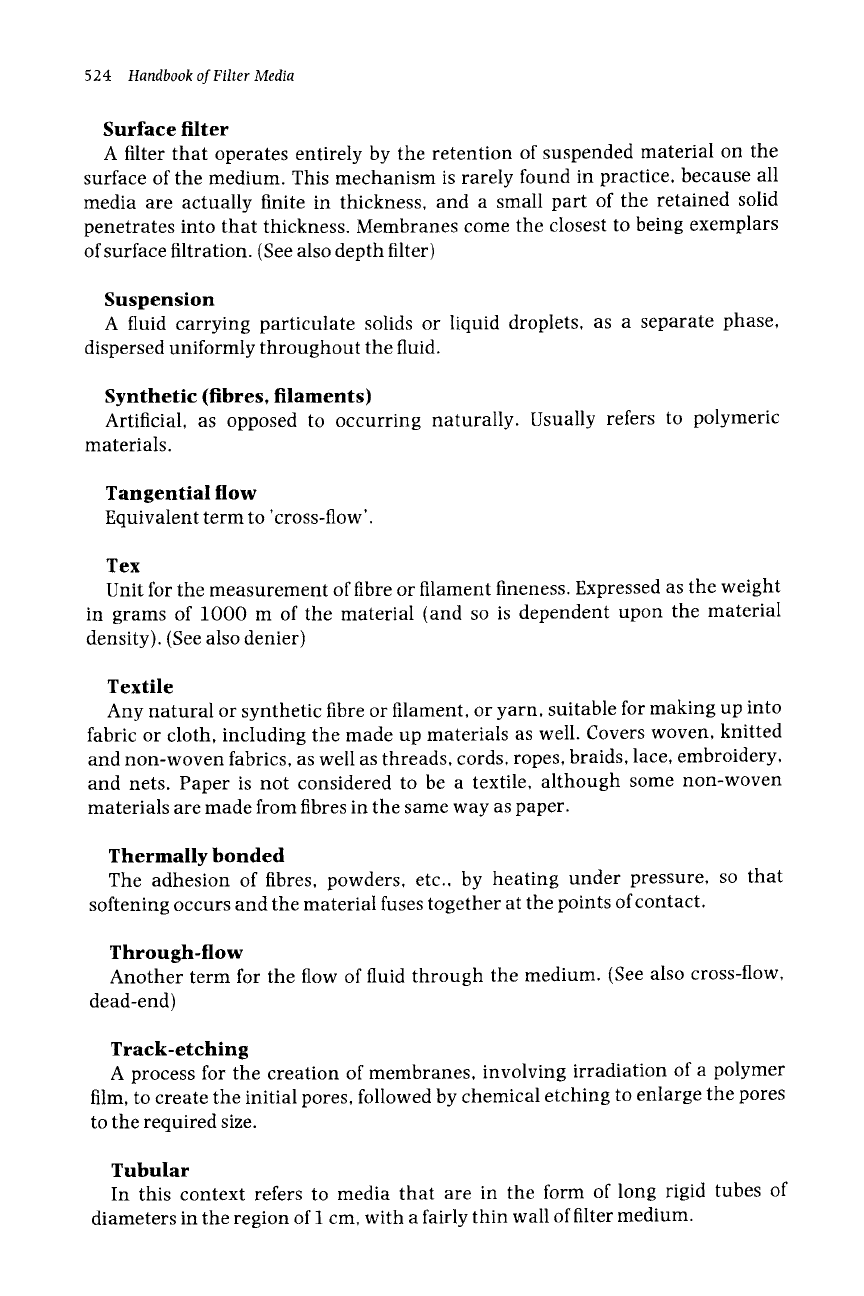
524 Handbook of Filter Media
Surface
filter
A filter that operates entirely by the retention of suspended material on the
surface of the medium. This mechanism is rarely found in practice, because all
media are actually finite in thickness, and a small part of the retained solid
penetrates into that thickness. Membranes come the closest to being exemplars
of surface filtration. (See also depth filter)
Suspension
A fluid carrying particulate solids or liquid droplets, as a separate phase,
dispersed uniformly throughout the fluid.
Synthetic (fibres, filaments)
Artificial, as opposed to occurring naturally. Usually refers to polymeric
materials.
Tangential flow
Equivalent term to 'cross-flow'.
Tex
Unit for the measurement of fibre or filament fineness. Expressed as the weight
in grams of 1000 m of the material (and so is dependent upon the material
density). (See also denier)
Textile
Any natural or synthetic fibre or filament, or yarn, suitable for making up into
fabric or cloth, including the made up materials as well. Covers woven, knitted
and non-woven fabrics, as well as threads, cords, ropes, braids, lace, embroidery,
and nets. Paper is not considered to be a textile, although some non-woven
materials are made from fibres in the same way as paper.
Thermally bonded
The adhesion of fibres, powders, etc., by heating under pressure, so that
softening occurs and the material fuses together at the points of contact.
Through-flow
Another term for the flow of fluid through the medium. (See also cross-flow,
dead-end)
Track-etching
A process for the creation of membranes, involving irradiation of a polymer
film, to create the initial pores, followed by chemical etching to enlarge the pores
to the required size.
Tubular
In this context refers to media that are in the form of long rigid tubes of
diameters in the region of I cm, with a fairly thin wall of filter medium.
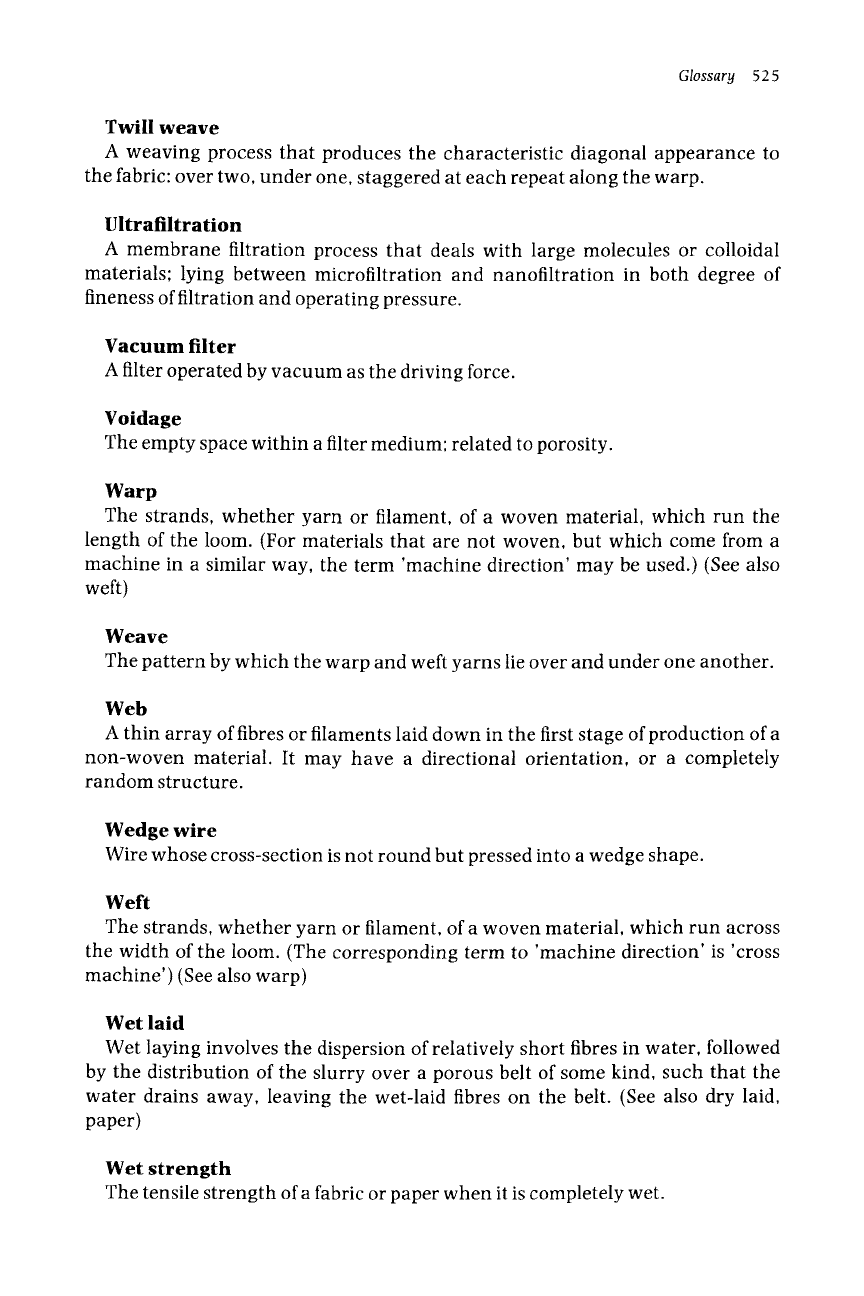
Glossary 52 5
Twill weave
A weaving process that produces the characteristic diagonal appearance to
the fabric: over two, under one, staggered at each repeat along the warp.
Ultrafiltration
A membrane filtration process that deals with large molecules or colloidal
materials; lying between microfiltration and nanofiltration in both degree of
fineness of filtration and operating pressure.
Vacuum filter
A filter operated by vacuum as the driving force.
Voidage
The empty space within a filter medium; related to porosity.
Warp
The strands, whether yarn or filament, of a woven material, which run the
length of the loom. (For materials that are not woven, but which come from a
machine in a similar way, the term 'machine direction' may be used.) (See also
weft)
Weave
The pattern by which the warp and weft yarns lie over and under one another.
Web
A thin array of fibres or filaments laid down in the first stage of production of a
non-woven material. It may have a directional orientation, or a completely
random structure.
Wedge wire
Wire whose cross-section is not round but pressed into a wedge shape.
Weft
The strands, whether yarn or filament, of a woven material, which run across
the width of the loom. (The corresponding term to 'machine direction' is 'cross
machine') (See also warp)
Wet laid
Wet laying involves the dispersion of relatively short fibres in water, followed
by the distribution of the slurry over a porous belt of some kind, such that the
water drains away, leaving the wet-laid fibres on the belt. (See also dry laid,
paper)
Wet strength
The tensile strength of a fabric or paper when it is completely wet.
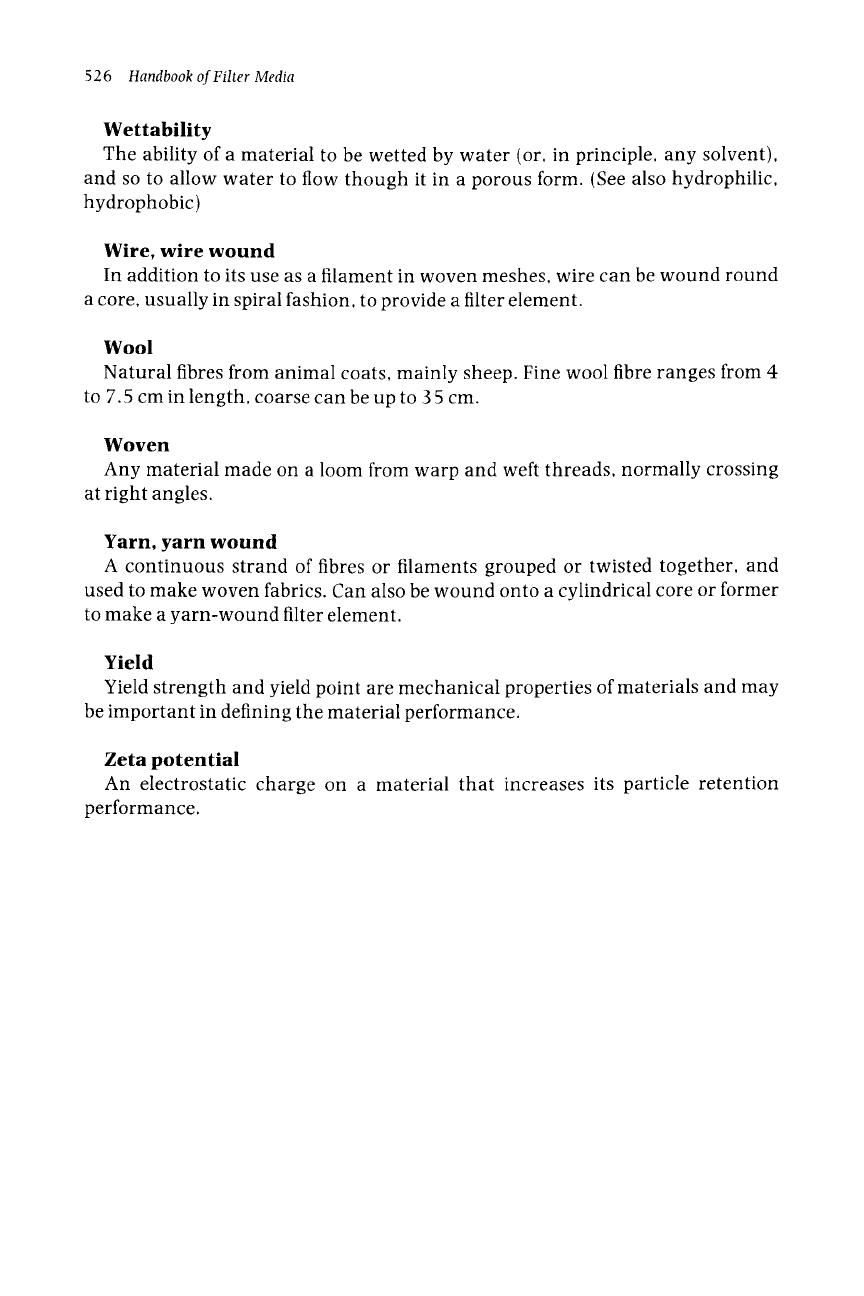
526 Handbook of Filter Media
Wettability
The ability of a material to be wetted by water (or, in principle, any solvent),
and so to allow water to flow though it in a porous form. (See also hydrophilic,
hydrophobic)
Wire, wire wound
In addition to its use as a filament in woven meshes, wire can be wound round
a core, usually in spiral fashion, to provide a filter element.
Wool
Natural fibres from animal coats, mainly sheep. Fine wool fibre ranges from 4
to 7.5 cm in length, coarse can be up to 3 5 cm.
Woven
Any material made on a loom from warp and weft threads, normally crossing
at right angles.
Yarn, yarn wound
A continuous strand of fibres or filaments grouped or twisted together, and
used to make woven fabrics. Can also be wound onto a cylindrical core or former
to make a yarn-wound filter element.
Yield
Yield strength and yield point are mechanical properties of materials and may
be important in defining the material performance.
Zeta potential
An electrostatic charge on a material that increases its particle retention
performance.
